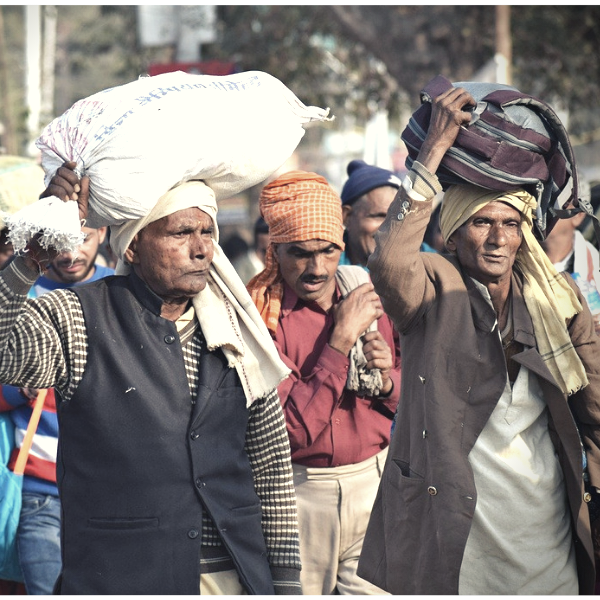This blog is part of the COMPAS Coronavirus and Mobility Forum. It is co-published with Routed: Migration and (Im)mobility Magazine in its special issue of “Epidemics, labour and mobility”
The everyday presence of migrant labourers in the cities of India would have gone unnoticed, had it not been for the COVID-19 lockdown. What followed after the sudden announcement of one of the strictest lockdowns in the world was the crisis of millions of migrant labourers – having lost their jobs, been evicted from their place of stay and left with nothing to eat – walking back from the New Delhi region to their home villages, also termed as the greatest man-made tragedy.
Exodus of migrant labourers from the city as a form of reaction, as an expression of their grievances, is not surprising. Such a form of mass spatial mobility has been used by migrant labourers in the recent past in similar or different scenarios, either in the light of the decisions taken by the state or the lack thereof.
Migrant labourers in India travel from their remote villages to far-off cities, covering a distance that could be as much as 1500 miles or as little as 10 miles. In this way, their exodus away from their villages is used proactively to sustain their livelihood. However, in the city, in working as construction labourers, street vendors, domestic workers, hotel workers, security guards, they continue to live in uncertain work arrangements, with irregular or delayed daily wage payments and in poor living conditions.
The Indian government’s 2016 announcement of a demonetisation policy banning existing currency notes and the introduction of GST (Goods and Services Tax) as a new taxation policy affected the everyday dependence of migrant labourers on cash. As a result, the sudden announcement led to their exodus from major destination cities in India after having lost their jobs in the city.
Similarly, 2008 witnessed migrant labourers of North Indian states such as Bihar and Uttar Pradesh leaving from the cities, such as Nasik, Pune, and Mumbai in Maharashtra, in large numbers. This exodus happened as a result of the migrants being accused by the state government of taking up the jobs of the native workers. Prior to 2008, it was the Tamil-speaking labourers from South India who had to flee the state for the same reasons, no longer feeling welcome.
Beyond these events of exodus, I recall two other events that emerged due to a lack of state action in cities of Karnataka and Gujarat. In 2012 rumours of violence targeting migrant workers from the North-East led them to flee the city of Bengaluru in the state of Karnataka. In another similar event more recently in 2018, owing to rumours linked to crime and violence, migrant labourers from Bihar and Uttar Pradesh fled the cities in the state of Gujarat. Later, the government of Gujarat also introduced policy measures restricting jobs for the migrant labourers in the cities.
It is in the light of the earlier episodes of exodus that we need to read the exodus of the COVID-19 lockdown. The lockdown, similar to earlier conditions triggering exodus, has enhanced the everyday uncertainty of migrant labourers, coupled with heightening their fear and job insecurity. Not only the New Delhi region, but in cities such as Mumbai, Surat, Hyderabad, Kerala, Bengaluru, migrant labourers’ persistent demands to go home were expressed through both silent and violent forms of protest. In fact, migrant labourers chose home over their host even when the host governments of Gujarat, Maharashtra, Karnataka, Telangana, tried to stop them from returning to their villages.
Exodus as an act has been studied and finds significance in scholarly writings as well. For instance, exodus of migrant labourers finds resonance within James C Scott’s research on the withdrawal action of peasants in a Malaysian village. Similarly, Ravi Ahuja places importance on the use of collective withdrawal of peasants as their ultimate resource against oppression. During the British Raj in India, indentured labour migration away from villages was also seen as an opportunity for enterprising Indians. In the current context of labour migration, Jan Breman, in his decades of experience of working with labour migrants in Gujarat, described the frequent to and fro village-city movement of labourers as a form of protest. Chinmay Tumbe, meanwhile, remarks upon economic security attracting migrant labourers to the city while social security in the villages compelling them to return back.
While India witnessed a massive exodus away from the cities, the debate shifted to migrant labourers' return to the city after the lockdown would be lifted. In fact, labourers have begun their return exodus back to the city. What stands clear is that migrant labourers, like in the past, have repeatedly used exodus to act either proactively or reactively in times of crisis and otherwise. While the recent exodus has been received with sympathy and concern on one hand while criminality on the other, it has also been seen as an expression of migrant workers’ deep distrust of the state. Ultimately, history has shown that when migrant labourers working in cities have bitter experiences with the state, they resort to leaving the city – and the recent example is no different.
About the author: Manish Maskara is currently pursuing a PhD in Development Studies from SOAS, London. In his research, he is examining the question of class formation for migrant labourers, taking the struggles of Bihari migrant labourers in India as the case. Broadly his interests lie in engaging with questions concerning emerging forms of labour politics, in particular that of migrant labourers, their livelihoods, associated daily struggles and their relation to development practice. Twitter: @maskaramanish25
